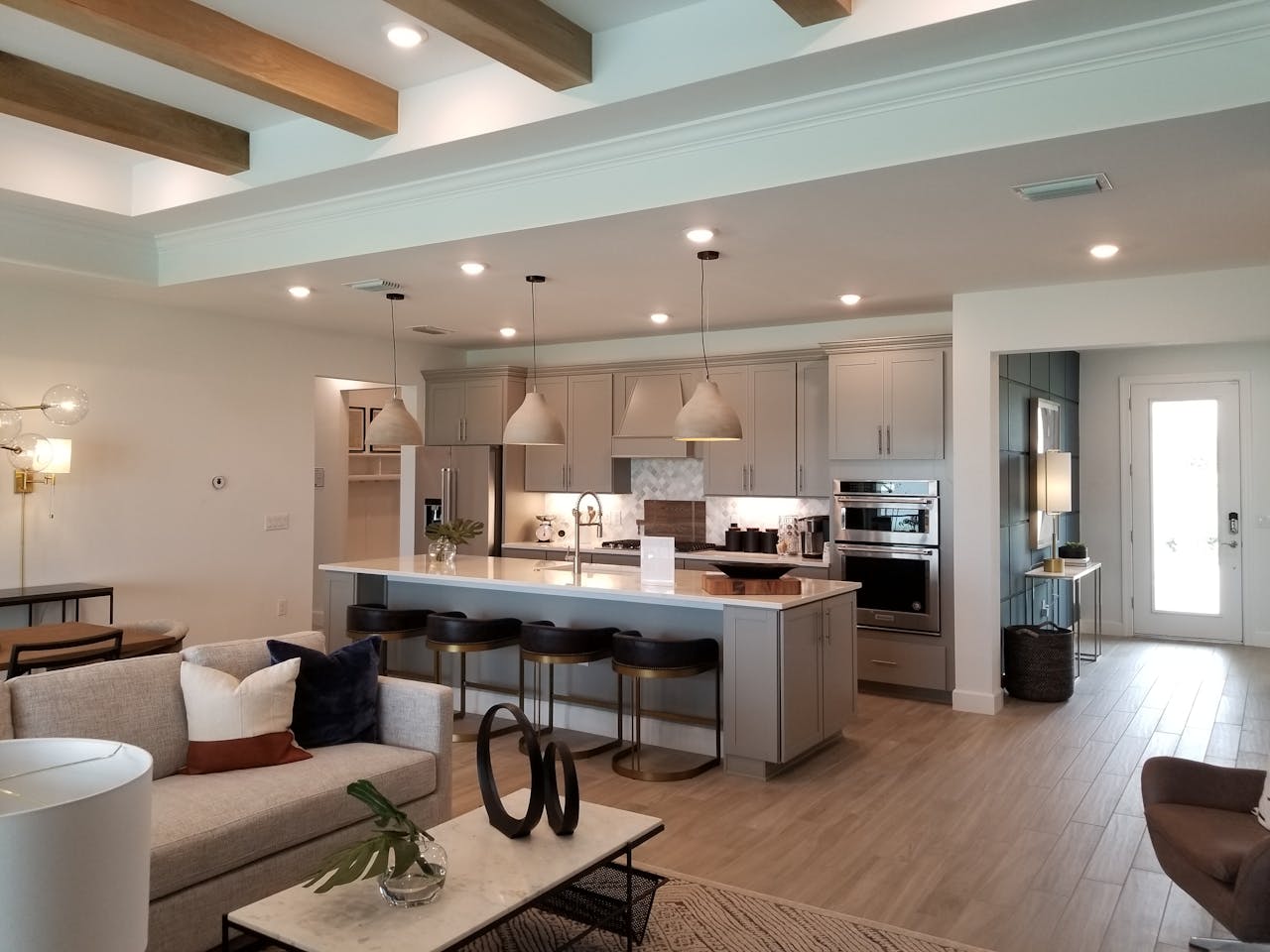Choosing the right type of flooring for your kitchen can be a daunting task. Many factors must be taken into account, such as durability, aesthetics, cost and, of course, safety. The kitchen, which is often the epicenter of activity in a home, is one area where slips and falls commonly occur, making it essential to select a floor that offers superior slip resistance. This article aims to guide you through the various options available, with a focus on those that offer the best resistance to slips, promoting safety in your kitchen.
Tile Flooring: Porcelain and Ceramic
Often, when we speak of tile flooring, we refer to two main types: porcelain and ceramic. These are popular choices due to their resilience, aesthetic versatility and easy-clean characteristics. Porcelain tiles, made from a denser type of clay, boast a high resistance to water, making them an excellent option for areas exposed to considerable moisture, like kitchens.
Also read : What are the health benefits of using an air fryer?
However, not all tiles are created equal when it comes to slip resistance. The surface of the tile plays a significant role. Tiles with a smooth, high-gloss finish may look appealing, but they can be dangerously slippery when wet. Opt for tiles with a textured surface or a matte finish, which tend to offer better grip, thereby reducing the risk of slipping.
Another factor to consider is the tile’s Porcelain Enamel Institute (PEI) rating, which measures the tile’s durability and ability to withstand wear. For high-traffic areas like the kitchen, tiles with a higher PEI rating (4 or 5) are recommended.
Have you seen this : What are the health benefits of using an air fryer?
Vinyl Flooring: A Cost-Effective Option
Vinyl flooring has been a long-standing popular choice for kitchen flooring due to its affordability, durability, and water resistance. Modern vinyl floors have come a long way from the dated patterns and designs of yesteryears; today, you can find vinyl mimicking the look of natural stone, hardwood, or high-end ceramic tiles.
Most importantly, vinyl flooring offers increased slip resistance. Some options come with a textured surface designed to prevent slips and falls. Moreover, vinyl is softer and more forgiving underfoot than tile or stone, which can be beneficial in the event of a fall.
However, while vinyl is easy to clean and maintain, it is not as long-lasting as other options. Over time, vinyl can fade, get scratched, or even tear, especially in high-traffic areas like kitchens.
Rubber Flooring: The Commercial Choice
Rubber flooring is often associated with commercial kitchens, and for a valid reason. This flooring option offers superior slip resistance, even when wet, making it a safety champion. Rubber is also extremely durable, able to withstand heavy foot traffic and the inevitable spills and stains that come with a busy kitchen.
Rubber flooring comes in a range of colors and styles, from sleek and modern to quirky and fun, enabling you to enhance your kitchen aesthetics while ensuring safety. Moreover, it is comfortable underfoot and easy to clean — a simple mop or vacuum can do the trick.
However, keep in mind that rubber flooring may not be as resistant to heat and can get discolored over time. Some may also find the initial smell of rubber off-putting, although this usually dissipates over time.
Hardwood and Laminate Flooring: A Balancing Act
Hardwood and laminate flooring offer a balance of beauty and functionality. Both options add a warm, natural charm to any kitchen, with hardwood being the more luxurious — and expensive — of the two. Both materials are relatively easy to clean and maintain, although hardwood is more susceptible to water damage.
Laminate flooring, which mimics the look of hardwood, is more resistant to water and stains. However, it can be slippery when wet. Some manufacturers offer laminate flooring with anti-slip coatings, but these can wear off over time.
Hardwood, on the other hand, offers better slip resistance, especially if it has an oil finish rather than a lacquer finish. Oiled floors have a more natural, rougher texture than lacquered floors, offering more grip.
In summary, while there’s no one-size-fits-all answer, several flooring options can effectively minimize slips in your kitchen. Consider factors like comfort, durability, aesthetics, cost, and of course, slip resistance when making your decision. After all, the kitchen is the heart of your home, and ensuring its safety is paramount.
Stone Flooring: Natural and Rugged
Stone flooring, with its natural, rugged finish, offers both an aesthetically pleasing and functional solution for your kitchen. Options can range from slate, granite, limestone to marble. Each type provides a unique look that can elevate the visual appeal of your kitchen while also providing a sturdy and durable surface.
Stone tiles are inherently slip-resistant due to their rough texture. This makes them an excellent choice for kitchens, where spills are common. However, they can be on the higher end of the price scale and would require routine sealing to maintain their appearance and slip resistance.
Despite this, the longevity and durability of stone flooring often make it a worthwhile investment. It can stand up to heavy foot traffic, dropped pots and pans, and still maintain its beauty over time. Moreover, easy clean characteristics make it a convenient option for busy kitchens.
One downside, however, is that stone flooring can be hard and cold underfoot. Using area rugs in strategic locations can help alleviate this, but it’s essential to choose anti-slip rugs to prevent trips and falls.
Epoxy Flooring: The Ultimate in Slip Resistance
Epoxy flooring is a type of protective and decorative coating applied over concrete floors. This type of flooring is highly durable, water-resistant, and offers excellent slip resistance. For those particularly concerned about slips and falls in the kitchen, epoxy flooring may be the best option.
The application of epoxy flooring results in a seamless and smooth surface that is easy to clean and maintain. The surface can also be textured for additional slip resistance.
Epoxy flooring is not only a practical choice but it’s also customizable. You can select from a wide variety of colors, patterns, and effects to match your kitchen decor. It’s also an economical solution, as it’s typically less expensive than traditional flooring materials.
However, it’s worth noting that installing epoxy flooring requires professional expertise. It’s not really a do-it-yourself project, as the process involves preparing the underlying concrete, mixing the epoxy coating, and applying it correctly to ensure a long-lasting, durable surface.
Conclusion: Making the Right Choice For Your Kitchen
Choosing the right kitchen flooring is a balance between aesthetics, durability, cost, and above all, safety. With so many flooring options available, it’s essential to consider their slip resistance and how they would fit into your kitchen’s overall design and usage.
From the timeless appeal of porcelain tiles to the rugged beauty of stone tiles, or even the modern and economical epoxy flooring, there’s a solution for every kitchen. Each has its pros and cons, but the common thread is their ability to provide a safer kitchen environment by minimizing slips and trips.
Remember, no matter what type of flooring you choose, regular maintenance and prompt cleanup of spills are crucial to keep your floor’s slip resistance at its best. After all, the aim is to enjoy your time in the kitchen without worrying about potential slip and fall accidents.






